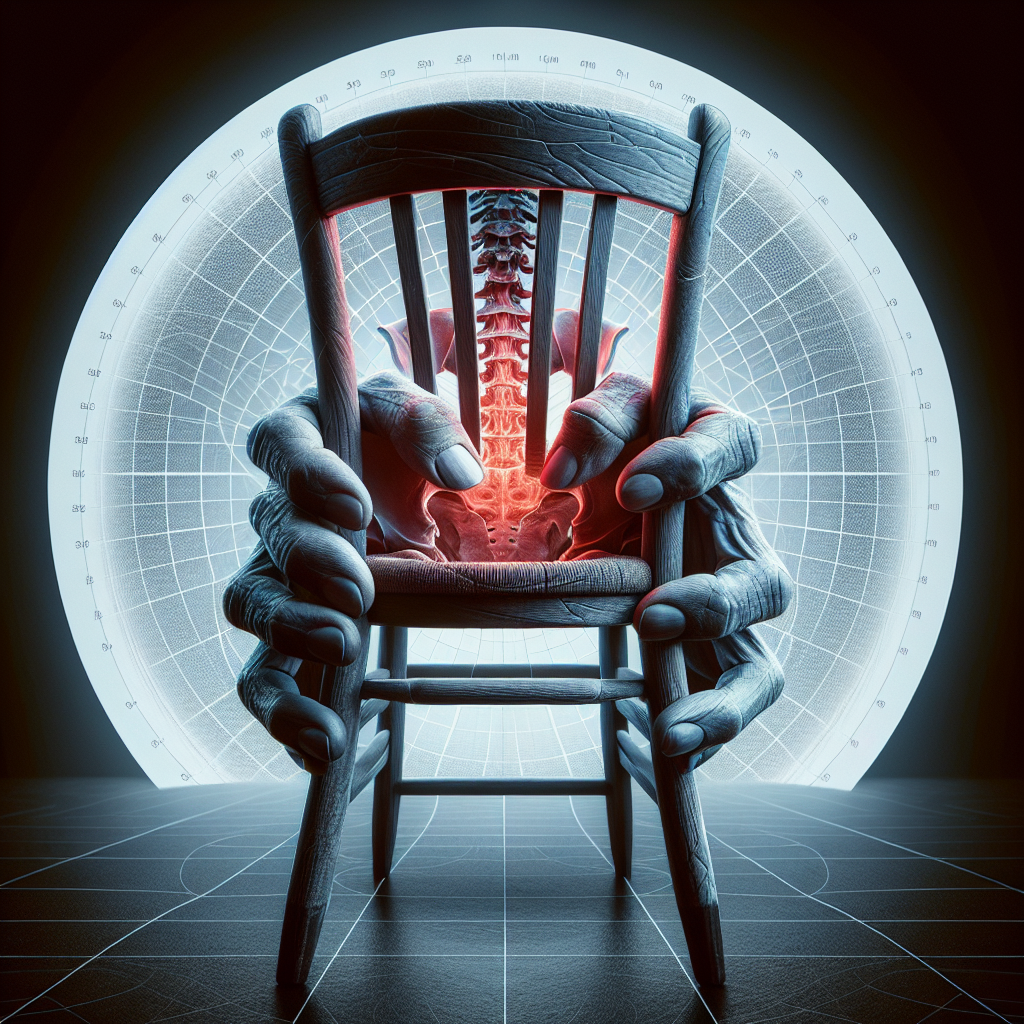Imagine a life free of back pain, where you can move freely and engage in activities you love without any limitations. This captivating article explores the surprising connection between prostate cancer and back pain, unveiling a link that may change the way we perceive and treat this prevalent disease. As you delve into the fascinating world of medical research and discoveries, you will uncover valuable insights into the symptoms, risk factors, and potential treatment options for those affected by prostate cancer-related back pain. So, sit back, relax, and prepare to unlock a world of knowledge that could make a significant impact on your life or the life of a loved one.

Understanding Prostate Cancer
What is Prostate Cancer?
Prostate cancer is a type of cancer that develops in the prostate gland, which is a small walnut-shaped gland present in men. The prostate gland is responsible for producing seminal fluid, a substance that nourishes and transports sperm. When cancer cells form in the prostate gland, it can lead to the development of prostate cancer.
Risk Factors for Prostate Cancer
There are several risk factors that may increase the likelihood of developing prostate cancer. Age is one of the significant risk factors, with the risk increasing as men get older. Family history also plays a role, as having a close relative with prostate cancer increases the chances of developing the disease. Ethnicity, with African American men having a higher risk, and lifestyle factors such as poor diet and lack of exercise, are also believed to contribute to the development of prostate cancer.
Signs and Symptoms of Prostate Cancer
Prostate cancer often shows no signs or symptoms in its early stages, which is why regular screenings are essential for early detection. However, as the disease progresses, some common signs and symptoms may emerge. These can include difficulty urinating, weak urine flow, blood in the urine or semen, erectile dysfunction, pain or discomfort in the pelvic area, and, as we will explore in more detail, back pain.
The Link Between Prostate Cancer and Back Pain
How Prostate Cancer May Cause Back Pain
Prostate cancer can cause back pain when cancer cells spread from the prostate gland to other parts of the body, such as the bones. This process, called metastasis, can result in the formation of tumors in the spine or other bones, leading to localized or radiating back pain.
Back Pain as an Early Sign of Prostate Cancer
In some cases, back pain can be an early sign of prostate cancer, indicating that the disease has already started to spread. It is important to note, however, that back pain can have various causes, and experiencing back pain does not necessarily mean one has prostate cancer. It is always advised to consult with a healthcare professional to determine the underlying cause of back pain.
Types of Back Pain Associated with Prostate Cancer
Localized Back Pain
Localized back pain refers to pain that is confined to a specific area of the back. In the case of prostate cancer, localized back pain may occur when cancer cells have spread to the spine, causing compression or damage to the vertebrae. This can result in localized pain, stiffness, and limited mobility.
Radiating Back Pain
Radiating back pain refers to pain that spreads from one area to another. In the context of prostate cancer, radiating back pain can occur when cancer cells spread to nearby tissues or organs, such as the lymph nodes or nerves. This can cause pain to radiate from the lower back down to the legs or other parts of the body.
Bone Pain
Bone pain is a common symptom of advanced prostate cancer, occurring when cancer cells have spread to the bones. The bones most commonly affected include the spine, hips, and pelvis. Bone pain may be constant or intermittent and can vary in intensity. It is important to address bone pain promptly to ensure appropriate management and care.
Diagnostic Tools for Prostate Cancer and Back Pain
Digital Rectal Examination (DRE)
A digital rectal examination (DRE) is a physical examination performed by a healthcare professional to assess the prostate gland. During this procedure, a gloved, lubricated finger is inserted into the rectum to check for any abnormalities or signs of prostate cancer, such as lumps or hard areas.
Prostate-Specific Antigen (PSA) Test
The prostate-specific antigen (PSA) test measures the levels of PSA in the blood. PSA is a protein produced by the prostate gland, and elevated levels may indicate the presence of prostate cancer. However, it is essential to note that an elevated PSA level does not necessarily mean that prostate cancer is present, as other factors can cause elevated PSA levels.
Biopsy
A biopsy involves the collection of tissue samples from the prostate gland for further examination under a microscope. This procedure is usually performed after abnormal findings on a DRE or an elevated PSA level. A biopsy can provide a definitive diagnosis of prostate cancer and help determine the stage and aggressiveness of the disease.
Imaging Tests
Imaging tests, such as bone scans, CT scans, or MRI scans, may be utilized to determine the extent of the spread of prostate cancer and identify any areas of bone involvement. These tests can help healthcare professionals develop a treatment plan and monitor the progression of the disease.

Treatment Options for Prostate Cancer and Associated Back Pain
Prostate Cancer Treatment Approaches
The treatment options for prostate cancer depend on various factors, including the stage of the disease, the aggressiveness of the cancer cells, and the overall health of the individual. Treatment approaches can include active surveillance, surgery, radiation therapy, hormone therapy, chemotherapy, and immunotherapy. The choice of treatment will be determined by the healthcare professional in collaboration with the patient.
Targeted Therapy for Back Pain Relief
For individuals experiencing back pain associated with prostate cancer, targeted therapy may be utilized to provide pain relief. This approach involves the use of medications or techniques that specifically target the cancer cells causing the pain, helping to alleviate symptoms and improve quality of life.
Managing Back Pain during Prostate Cancer Treatment
Pain Medications
Pain medications, such as analgesics or opioids, may be prescribed to help manage back pain during prostate cancer treatment. These medications can provide temporary relief and improve overall comfort. It is essential to follow the prescribed dosage and consult with a healthcare professional regarding any potential side effects or interactions.
Physical Therapy and Exercise
Physical therapy and exercise can play an essential role in managing back pain associated with prostate cancer. A skilled physical therapist can design a personalized program that includes stretching, strengthening exercises, and techniques to improve posture and body mechanics. These strategies can help reduce pain, improve mobility, and enhance overall physical well-being.
Alternative and Complementary Therapies
Alternative and complementary therapies, such as acupuncture, massage therapy, and relaxation techniques, may be considered as part of a comprehensive approach to managing back pain during prostate cancer treatment. These therapies can provide additional pain relief, stress reduction, and promote overall well-being. It is crucial to discuss these options with a healthcare professional and ensure they are integrated into the treatment plan safely and effectively.

Prevention Strategies for Prostate Cancer and Back Pain
Maintaining a Healthy Lifestyle
Maintaining a healthy lifestyle can help reduce the risk of developing prostate cancer and associated back pain. This includes eating a balanced diet rich in fruits, vegetables, and whole grains, exercising regularly, maintaining a healthy weight, and avoiding tobacco and excessive alcohol consumption. Additionally, staying hydrated and practicing good posture can also contribute to overall spinal health.
Screening and Early Detection
Screening and early detection play a crucial role in identifying prostate cancer at its earlier stages when treatment options are more effective. Regular screenings, including PSA tests and DREs, should be discussed with a healthcare professional to determine the appropriate screening schedule based on individual risk factors. Early detection can help improve survival rates and reduce the likelihood of experiencing severe back pain associated with advanced prostate cancer.
Support and Resources for Prostate Cancer and Back Pain
Support Groups and Counseling
Support groups and counseling can be valuable resources for individuals and their families navigating the challenges of prostate cancer and associated back pain. These groups provide a supportive environment where individuals can share experiences, receive emotional support, and access valuable information and coping strategies. Counseling services can also offer individualized support to address specific emotional and psychological needs.
Online Resources and Communities
Online resources and communities provide a wealth of information, support, and connection for individuals affected by prostate cancer and back pain. Websites, forums, and social media groups dedicated to prostate cancer can offer educational materials, treatment updates, and opportunities for virtual interaction with others facing similar experiences. It is important to ensure that online sources are reputable and evidence-based.
Coping with the Emotional Impact of Prostate Cancer and Back Pain
Emotional Challenges of Prostate Cancer
Prostate cancer and associated back pain can have a significant emotional impact on both individuals and their loved ones. Feelings of fear, anxiety, sadness, and uncertainty are common. It is important to acknowledge and address these emotions, as they can impact overall well-being and treatment outcomes. Open communication, support systems, and professional counseling can assist in coping with the emotional challenges that arise.
Developing Coping Strategies
Developing effective coping strategies is crucial for managing the emotional impact of prostate cancer and back pain. This may involve seeking support from loved ones, engaging in stress-reducing activities such as hobbies or meditation, maintaining a positive outlook, and staying informed about treatment options and progress. Each person’s coping strategies will be unique, and it is essential to find approaches that resonate with individual needs and preferences.
Conclusion
Understanding the relationship between prostate cancer and back pain is crucial for early detection, effective treatment, and improved quality of life. By recognizing the potential signs and symptoms of prostate cancer, being aware of the various types of back pain associated with the disease, and utilizing appropriate diagnostic tools, individuals can take proactive steps in managing their health. With the support of healthcare professionals, loved ones, and resources available, those affected by prostate cancer and back pain can navigate the challenges and maintain a positive outlook on their journey to recovery and well-being.

